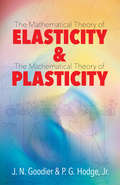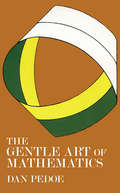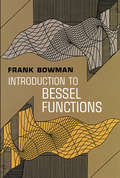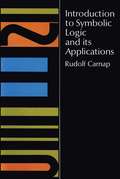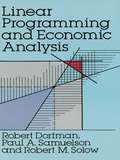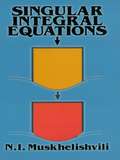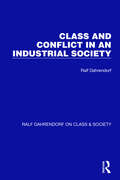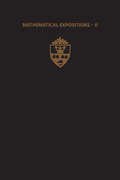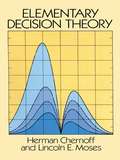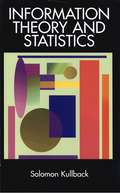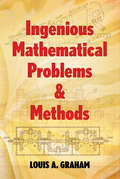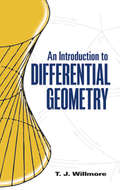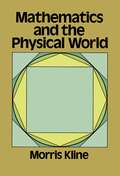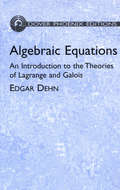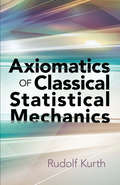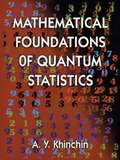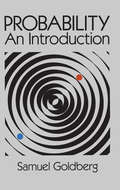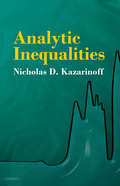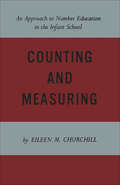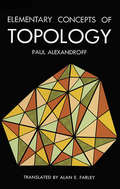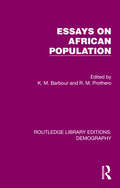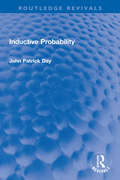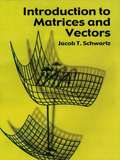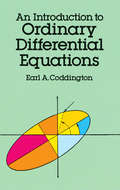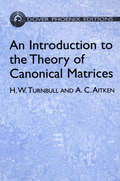- Table View
- List View
Elasticity and Plasticity: The Mathematical Theory of Elasticity and The Mathematical Theory of Plasticity (Dover Books on Mathematics)
by J. N. Goodier P. G. Hodge Jr.This volume comprises two classic essays on the mathematical theories of elasticity and plasticity by authorities in this area of engineering science. Undergraduate and graduate students in engineering as well as professional engineers will find these works excellent texts and references. The Mathematical Theory of Elasticity covers plane stress and plane strain in the isotropic medium, holes and fillets of assignable shapes, approximate conformal mapping, reinforcement of holes, mixed boundary value problems, the third fundamental problem in two dimensions, eigensolutions for plane and axisymmetric states, anisotropic elasticity, thermal stress, elastic waves induced by thermal shock, three-dimensional contact problems, wave propagation, traveling loads and sources of disturbance, diffraction, and pulse propagation. The Mathematical Theory of Plasticity explores the theory of perfectly plastic solids, the theory of strain-hardening plastic solids, piecewise linear plasticity, minimum principles of plasticity, bending of a circular plate, and other problems.
The Gentle Art of Mathematics
by Dan PedoeMathematical games, probability, the question of infinity, topology, how the laws of algebra work, problems of irrational numbers, and more. 42 figures.
Introduction to Bessel Functions (Dover Books on Mathematics)
by Frank BowmanA full, clear introduction to the properties and applications of Bessel functions, this self-contained text is equally useful for the classroom or for independent study. Topics include Bessel functions of zero order, modified Bessel functions, definite integrals, asymptotic expansions, and Bessel functions of any real order. More than 200 problems throughout.
Introduction to Symbolic Logic and Its Applications
by Rudolf CarnapA clear, comprehensive, and rigorous treatment develops the subject from elementary concepts to the construction and analysis of relatively complex logical languages. It then considers the application of symbolic logic to the clarification and axiomatization of theories in mathematics, physics, and biology. Hundreds of problems, examples, and exercises. 1958 edition.
Linear Programming and Economic Analysis (Dover Books on Computer Science)
by Paul A. Samuelson Robert M. Solow Robert DorfmanDesigned primarily for economists and those interested in management economics who are not necessarily accomplished mathematicians, this text offers a clear, concise exposition of the relationship of linear programming to standard economic analysis. The research and writing were supported by The RAND Corporation in the late 1950s.Linear programming has been one of the most important postwar developments in economic theory, but until publication of the present volume, no text offered a comprehensive treatment of the many facets of the relationship of linear programming to traditional economic theory. This book was the first to provide a wide-ranging survey of such important aspects of the topic as the interrelations between the celebrated von Neumann theory of games and linear programming, and the relationship between game theory and the traditional economic theories of duopoly and bilateral monopoly.Modern economists will especially appreciate the treatment of the connection between linear programming and modern welfare economics and the insights that linear programming gives into the determinateness of Walrasian equilibrium. The book also offers an excellent introduction to the important Leontief theory of input-output as well as extensive treatment of the problems of dynamic linear programming. Successfully used for three decades in graduate economics courses, this book stresses practical problems and specifies important concrete applications.
Singular Integral Equations: Boundary Problems of Function Theory and Their Application to Mathematical Physics
by N. I. MuskhelishviliSingular integral equations play important roles in physics and theoretical mechanics, particularly in the areas of elasticity, aerodynamics, and unsteady aerofoil theory. They are highly effective in solving boundary problems occurring in the theory of functions of a complex variable, potential theory, the theory of elasticity, and the theory of fluid mechanics.This high-level treatment by a noted mathematician considers one-dimensional singular integral equations involving Cauchy principal values. Its coverage includes such topics as the Hölder condition, Hilbert and Riemann-Hilbert problems, the Dirichlet problem, inversion formulas for arcs, and many other areas. Intended for graduate students, applied and pure mathematicians, engineers, physicists, and researchers in a variety of scientific and industrial fields, this text is accessible to students acquainted with the basic theory of functions of a complex variable and the theory of Fredholm integral equations.
Class and Conflict in an Industrial Society (Ralf Dahrendorf on Class & Society #1)
by Ralf DahrendorfOriginally published in England in 1959, this book evolves a new theory of conflict in industrial society. By way of illustrating and testing this theory, the book provides detailed analyses of various social phenomena. The author carries out a full critique of Marx in the light of history and modern sociology and discusses the theories of class-conflict of James Burnham, Fritz Croner and Karl Renner.
Differential Geometry (Mathematical Expositions #no. 11)
by Erwin KreyszigThis book is intended to meet the need for a text introducing advanced students in mathematics, physics, and engineering to the field of differential geometry. It is self-contained, requiring only a knowledge of the calculus. The material is presented in a simple and understandable but rigorous manner, accompanied by many examples which illustrate the ideas, methods, and results. The use of tensors is explained in detail, not omitting little formal tricks which are useful in their applications. Though never formalistic, it provides an introduction to Riemannian geometry.<P><P> The theory of curves and surfaces in three-dimensional Euclidean space is presented in a modern way, and applied to various classes of curves and surfaces which are of practical interest in mathematics and its applications to physical, cartographical, and engineering problems. Considerable space is given to explaining and illustrating basic concepts such as curve, arc length, surface, fundamental forms; covariant and contravariant vectors; covariant, contravariant and mixed tensors, etc.<P> Interesting problems are included and complete solutions are given at the end of the book, together with a list of the more important formulae. No pains have been spared in constructing suitable figures.
Elementary Decision Theory (Dover Books on Mathematics)
by Lincoln E. Moses Herman Chernoff"The text is very clearly written [with] many illustrative examples and exercises [and] should be considered by those instructors who would like to introduce a more modern (and a more logical) approach in a basic course in statistics." --Journal of the American Statistical AssociationThis volume is a well-known, well-respected introduction to a lively area of statistics. Professors Chernoff and Moses bring years of professional expertise as classroom teachers to this straightforward approach to statistical problems. And happily, for beginning students, they have by-passed involved computational reasonings which would only confuse the mathematical novice.Developed from nine years of teaching statistics at Stanford, the book furnishes a simple and clear-cut method of exhibiting the fundamental aspects of a statistical problem. Beginners will find this book a motivating introduction to important mathematical notions such as set, function and convexity. Examples and exercises throughout introduce new topics and ideas.The first seven chapters are recommended for beginning courses in the basic ideas of statistics and require only a knowledge of high school math. These sections include material on data processing, probability and random variables, utility and descriptive statistics, uncertainty due to ignorance of the state of nature, computing Bayes strategies and an introduction to classical statistics. The last three chapters review mathematical models and summarize terminology and methods of testing hypotheses. Tables and appendixes provide information on notation, shortcut computational formulas, axioms of probability, properties of expectations, likelihood ratio test, game theory, and utility functions.Authoritative, yet elementary in its approach to statistics and statistical theory, this work is also concise, well-indexed and abundantly equipped with exercise material. Ideal for a beginning course, this modestly priced edition will be especially valuable to those interested in the principles of statistics and scientific method.
Information Theory and Statistics
by Solomon KullbackHighly useful text studies logarithmic measures of information and their application to testing statistical hypotheses. Includes numerous worked examples and problems. References. Glossary. Appendix. 1968 2nd, revised edition.
Ingenious Mathematical Problems and Methods
by Louis A. GrahamFor two decades, an international readership of workers in applied mathematics submitted their favorite puzzles to a mid-twentieth-century column, The Graham Dial. This original collection features 100 of the publication's very best problems, with themes ranging from logic and engineering situations to number theory and geometry. Each problem was specifically selected for its widely differing modes of solution, and most include several methods of solution plus assessments of their efficacy.In checking their solutions against the book's, readers may find that their interest in the puzzles increases. The search for an answer can develop into a challenge to improve upon existing solutions, as in a friendly competition among dozens of keen-witted, problem-solving engineers and mathematical puzzle fans. More than two dozen "mathematical nursery rhymes" appear throughout the book, which concludes with a final section of 25 "quickies" that will test readers' speed.
An Introduction to Differential Geometry
by T. J. WillmoreA solid introduction to the methods of differential geometry and tensor calculus, this volume is suitable for advanced undergraduate and graduate students of mathematics, physics, and engineering. Rather than a comprehensive account, it offers an introduction to the essential ideas and methods of differential geometry.Part 1 begins by employing vector methods to explore the classical theory of curves and surfaces. An introduction to the differential geometry of surfaces in the large provides students with ideas and techniques involved in global research. Part 2 introduces the concept of a tensor, first in algebra, then in calculus. It covers the basic theory of the absolute calculus and the fundamentals of Riemannian geometry. Worked examples and exercises appear throughout the text.
Mathematics and the Physical World
by Morris Kline"Kline is a first-class teacher and an able writer. . . . This is an enlarging and a brilliant book." - Scientific American"Dr. Morris Kline has succeeded brilliantly in explaining the nature of much that is basic in math, and how it is used in science." - San Francisco ChronicleSince the major branches of mathematics grew and expanded in conjunction with science, the most effective way to appreciate and understand mathematics is in terms of the study of nature. Unfortunately, the relationship of mathematics to the study of nature is neglected in dry, technique-oriented textbooks, and it has remained for Professor Morris Kline to describe the simultaneous growth of mathematics and the physical sciences in this remarkable book. In a manner that reflects both erudition and enthusiasm, the author provides a stimulating account of the development of basic mathematics from arithmetic, algebra, geometry, and trigonometry, to calculus, differential equations, and the non-Euclidean geometries. At the same time, Dr. Kline shows how mathematics is used in optics, astronomy, motion under the law of gravitation, acoustics, electromagnetism, and other phenomena. Historical and biographical materials are also included, while mathematical notation has been kept to a minimum. This is an excellent presentation of mathematical ideas from the time of the Greeks to the modern era. It will be of great interest to the mathematically inclined high school and college student, as well as to any reader who wants to understand - perhaps for the first time - the true greatness of mathematical achievements.
Algebraic Equations: An Introduction to the Theories of Lagrange and Galois
by Edgar DehnMeticulous and complete, this presentation of Galois' theory of algebraic equations is geared toward upper-level undergraduate and graduate students. The theories of both Lagrange and Galois are developed in logical rather than historical form. And they are given a more thorough exposition than is customary. For this reason, and also because the author concentrates on concrete applications of algebraic theory, Algebraic Equations is an excellent supplementary text, offering students a concrete introduction to the abstract principles of Galois theory. Of further value are the many numerical examples throughout the book, which appear with complete solutions.A third of the text focuses on the basic ideas of algebraic theory, giving detailed explanations of integral functions, permutations, and groups. in addition to a very clear exposition of the symmetric group and its functions. A study of the theory of Lagrange follows. Using Lagrange's solvent as a basis for the solution of the general quadratic, cubic, and biquadratic equations. After a discussion of various groups (including isomorphic, transitive, and Abelian groups), a detailed study of Galois theory covers the properties of the Galoisian function, resolvent. and group, the general equation, reductions of the group, natural irrationality. and other features. The book concludes with the application of Galoisian theory to the solution of such special equations as Abelian, cyclic, metacyclic, and quintic equations.
Axiomatics of Classical Statistical Mechanics (Dover Books on Physics #Volume 11)
by Rudolf KurthRequiring only familiarity with elements of calculus and analytical geometry, this monograph constructs classical statistical mechanics as a deductive system, based on equations of motion and basic postulates of probability. 1960 edition.
Mathematical Foundations of Quantum Statistics (Dover Books on Mathematics)
by A. Y. KhinchinA coherent, well-organized look at the basis of quantum statistics’ computational methods, the determination of the mean values of occupation numbers, the foundations of the statistics of photons and material particles, thermodynamics.
Probability: An Introduction
by Samuel GoldbergExcellent basic text covers set theory, probability theory for finite sample spaces, binomial theorem, probability distributions, means, standard deviations, probability function of binomial distribution, and other key concepts and methods essential to a thorough understanding of probability. Designed for use by math or statistics departments offering a first course in probability. 360 illustrative problems with answers for half. Only high school algebra needed. Chapter bibliographies.
Analytic Inequalities
by Nicholas D. KazarinoffMathematical analysis is largely a systematic study and exploration of inequalities -- but for students the study of inequalities often remains a foreign country, difficult of access. This book is a passport to that country, offering a background on inequalities that will prepare undergraduates (and even high school students) to cope with the concepts of continuity, derivative, and integral.Beginning with explanations of the algebra of inequalities and conditional inequalities, the text introduces a pair of ancient theorems and their applications. Explorations of inequalities and calculus cover the number e, examples from the calculus, and approximations by polynomials. The final sections present modern theorems, including Bernstein's proof of the Weierstrass approximation theorem and the Cauchy, Bunyakovskii, Hölder, and Minkowski inequalities. Numerous figures, problems, and examples appear throughout the book, offering students an excellent foundation for further studies of calculus.
Counting and Measuring: An Approach to Number Education in the Infant School
by Eileen M. ChurchillThe teaching of numbers in the primary grades is seen in this book as the foundation of the beginnings of mathematical understanding. Mathematics is taken to be a language, and the aim of its teaching is to make the pupil, so to speak, bilingual, or so to increase his understanding that he is able to translate a concrete numerical problem into the symbolic language of calculation. For a child taught along these lines, how much easier, for example, would be the transition from arithmetic to algebra!<P><P>Miss Churchill is fully conversant with the works of Piaget, Cuisenaire, Cassirer and other leading thinkers in educational philosophy, psychology, and linguistics. She has synthesized their concepts with her own experience and research at Leeds University, and, though written within the contexts of British education, her book should also have a marked influence on the teaching of young children in North America.
Elementary Concepts of Topology
by Paul AlexandroffAlexandroff's beautiful and elegant introduction to topology was originally published in 1932 as an extension of certain aspects of Hilbert's Anschauliche Geometrie. The text has long been recognized as one of the finest presentations of the fundamental concepts, vital for mathematicians who haven't time for extensive study and for beginning investigators.The book is not a substitute for a systematic text, but an unusually useful intuitive approach to the basic concepts. Its aim is to present these concepts in a clear, elementary fashion without sacrificing their profundity or exactness and to give some indication of how they are useful in increasingly more areas of mathematics. The author proceeds from the basics of set-theoretic topology, through those topological theorems and questions which are based upon the concept of the algebraic complex, to the concept of Betti groups which binds together central topological theories in a whole and upon which applications of topology largely rest.Wholly consistent with current investigations, in which a larger and larger part of topology is governed by the concept of homology, the book deals primarily with the concepts of complex, cycle, and homology. It points the way toward a systematic and entirely geometrically oriented theory of the most general structures of space.First English translation, prepared for Dover by Alan E. Farley. Preface by David Hilbert. Author's Foreword. Index. 25 figures.
Essays on African Population (Routledge Library Editions: Demography #16)
by K. M. BarbourOriginally published in 1961, this book comprises of 14 studies by scholars and officials with first-hand experience of Africa and deals with the nature and organization of population censuses and with the many uses to which their results may be put. Written at a time of political transition on the African continent it was vitally important that the collection and interpretation of statistics dealing with distribution, density, migration and occupation in Africa continued. This volume shows how demographers, sociologists, anthropologists and geographers were using the research to be followed in the interpretation of the numerous censuses being conducted in the early 1960s.
Inductive Probability (Routledge Revivals)
by J. P. DayFirst published in 1961, Inductive Probability is a dialectical analysis of probability as it occurs in inductions. The book elucidates on the various forms of inductive, the criteria for their validity, and the consequent probabilities. This survey is complemented with a critical evaluation of various arguments concerning induction and a consideration of relation between inductive reasoning and logic. The book promises accessibility to even casual readers of philosophy, but it will hold particular interest for students of Philosophy, Mathematics and Logic.
Introduction to Matrices and Vectors (Dover Books on Mathematics)
by Jacob T. SchwartzRealizing that matrices can be a confusing topic for the beginner, the author of this undergraduate text has made things as clear as possible by focusing on problem solving, rather than elaborate proofs. He begins with the basics, offering students a solid foundation for the later chapters on using special matrices to solve problems.The first three chapters present the basics of matrices, including addition, multiplication, and division, and give solid practice in the areas of matrix manipulation where the laws of algebra do not apply. In later chapters the author introduces vectors and shows how to use vectors and matrices to solve systems of linear equations. He also covers special matrices -- including complex numbers, quaternion matrices, and matrices with complex entries -- and transpose matrices; the trace of a matrix; the cross product of matrices; eigenvalues and eigenvectors; and infinite series of matrices. Exercises at the end of each section give students further practice in problem solving. Prerequisites include a background in algebra, and in the later chapters, a knowledge of solid geometry. The book was designed as an introductory text for college freshmen and sophomores, but selected chapters can also be used to supplement advanced high school classes. Professionals who need a better understanding or review of the subject will also benefit from this concise guide.
An Introduction to Ordinary Differential Equations
by Earl A. Coddington"Written in an admirably cleancut and economical style." -- Mathematical Reviews. This concise text offers undergraduates in mathematics and science a thorough and systematic first course in elementary differential equations. Presuming a knowledge of basic calculus, the book first reviews the mathematical essentials required to master the materials to be presented. The next four chapters take up linear equations, those of the first order and those with constant coefficients, variable coefficients, and regular singular points. The last two chapters address the existence and uniqueness of solutions to both first order equations and to systems and n-th order equations. Throughout the book, the author carries the theory far enough to include the statements and proofs of the simpler existence and uniqueness theorems. Dr. Coddington, who has taught at MIT, Princeton, and UCLA, has included many exercises designed to develop the student's technique in solving equations. He has also included problems (with answers) selected to sharpen understanding of the mathematical structure of the subject, and to introduce a variety of relevant topics not covered in the text, e.g. stability, equations with periodic coefficients, and boundary value problems.
An Introduction to the Theory of Canonical Matrices
by H. W. Turnbull A. C. AitkenThorough and self-contained, this penetrating study of the theory of canonical matrices presents a detailed consideration of all the theory's principal features. Topics include elementary transformations and bilinear and quadratic forms; canonical reduction of equivalent matrices; subgroups of the group of equivalent transformations; and rational and classical canonical forms. The final chapters explore several methods of canonical reduction, including those of unitary and orthogonal transformations. 1952 edition. Index. Appendix. Historical notes. Bibliographies. 275 problems.
